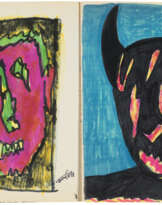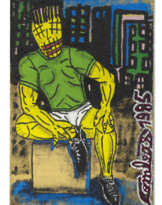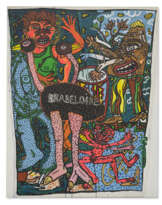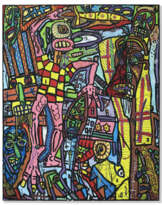ID 832082
Los 36 | Robert Combas (né en 1957)
Schätzwert
€ 150 000 – 250 000
Portrait stylisé de Daniel
signé et daté 'Combas 1987' (le long du bord droit)
acrylique sur drap panthère marouflé sur toile
222 x 130 cm.
Peint en 1987
signed and dated 'Combas 1987' (along the right edge)
acrylic on panther sheet laid on canvas
87 3/8 x 51 1/8 in.
Painted in 1987
Provenance
Vente, Me Cornette de Saint-Cyr, Paris, 11 octobre 1989, lot 124.
Acquis au cours de cette vente par le propriétaire actuel.
Literature
J. Palette, LE FAN, ETC, Paris, 1989 (illustré p. 108/109).
Special notice
Artist's Resale Right ("droit de Suite").
If the Artist's Resale Right Regulations 2006 apply to this lot, the buyer also agrees to pay us an amount equal to the resale royalty provided for in those Regulations, and we undertake to the buyer to pay such amount to the artist's collection agent.
This item will be transferred to an offsite warehouse after the sale. Please refer to department for information about storage charges and collection
details.
Post lot text
« Daniel l'Africanos aime les oiseaux et se prend pour Miró. D'ailleurs, pas la peine de se prendre, il est Miró depuis toujours. Il ne sait mème pas où mettre ses mains, à part quand il se tripote dans la chaleur de ses draps en peau de panthère en Nylon. Daniel il aimerait ètre noir comme Nino Ferrer. Il aimerait devenir chef sorcier dans un village d'indigènes. » Robert Combas « Ce qui importe dans une œuvre d’art, c’est la profondeur vitale d’où elle a pu jaillir. » James Joyce La peinture de Robert Combas est un maëlstrom d’énergie qui sans cesse semble déborder les limites de la toile. Elle est exubérante, bigarrée, drôle, acide, volontiers sexuelle, souvent violente, manifestant une puissance bouillonnante et féconde. Elle est libre – et c’est en ce sens qu’il faut entendre le rôle moteur qu’a joué l’artiste au sein du mouvement de la Figuration Libre, initié au début des années 1980 par Ben et réunissant un groupe de peintres faisant fi des hiérarchies artistiques et s’adonnant sans contraintes à un traitement du réel à rebours des courants abstraits et du minimalisme froid en vogue au cours des deux décennies précédentes. Mais par sa façon singulière d’envahir totalement l’ensemble du plan de la toile, abolissant toute notion d’arrière-plan ou de premier-plan, l’œuvre de Combas brouille les pistes et s’approche parfois presque d’un traitement abstrait de la composition : « C’est de la peinture figurative, mais justement, il y a presque un côté abstrait […]. On ne regarde plus l’image principale, celui qui est devant ; on regarde tout finalement » (Robert Combas interviewé in catalogue d’exposition, Bordeaux, CAPC, Robert Combas, mars-avril 1987, p. 11). Le Portrait stylisé de Daniel offre la vision percutante d’un grand personnage en pied, dégingandé et échevelé, déployant une palette chromatique éclatante sur fond exotique de motif à peau de panthère. Cet homme singulier rappelle les autoportraits de Jean-Michel Basquiat, autant qu’il semble faire un écho lointain aux personnages des légendes de Jean Dubuffet ; les trois artistes partageant un intérêt pour les personnages éberlués et ayant contribué, chacun à leur manière, à bousculer les canons artistiques établis, à faire entrer l’énergie de la rue, des dissidents et des marginaux dans leurs créations. Ce faisant, Combas retrouve un état quasi primitif de la peinture, dans son expression la plus essentielle et la plus brute, ainsi que l’écrit Michel Onfray et dont ce portrait de « Daniel l’Africanos » offre une illustration flamboyante : « Si Combas dispose d’un véritable ancêtre dans l’histoire de l’art, c’est bien l’artiste anonyme qui dessine et peint des odyssées dans les cavernes préhistoriques à la lumière jaune des torches et aux parfums sauvages des lampes à graisse animale » (Michel Onfray in catalogue d’exposition, Lyon, Musée d’art contemporain, Greatest hits, Robert Combas, février-juillet 2012, p. 20). "Daniel l’Africanos loves birds and believes he is Miró. In fact, he has always been Miró. He doesn't even know where to put his hands, except when he's fiddling around in the warmth of his Nylon panther skin sheets. Daniel would like to be black like Nino Ferrer. He would like to become a chief wizard in a village of natives.” Robert Combas “What matters in a work of art is the vital depth from where it sprang.” James Joyce The painting of Robert Combas is a maelstrom of energy that constantly seems to overflow the limits of the canvas. It is exuberant, colourful, funny, acid, willingly sexual, often violent, showing a bubbling and fertile power. It is free —and it is in this sense that one must understand the driving role that the artist played within the Free Figuration movement, initiated in the early 1980s by Ben. This movement brought together a group of painters who disregarded artistic hierarchies and devoted themselves without constraint to a treatment of reality contrasting with the abstract currents and cold minimalism in vogue during the previous two decades. But by his singular way of completely invading the entire space of the canvas, abolishing any notion of background or foreground, the work of Combas blurs the tracks and sometimes almost approaches an abstract treatment of the composition: “It is figurative painting, but precisely, there is almost an abstract side [...]. We no longer look at the main image, the one in front; we look at everything at the end” (Robert Combas interviewed in the exhibition catalogue, Bordeaux, CAPC, Robert Combas, March-April 1987, p. 11). The stylized Portrait of Daniel offers the striking vision of a large, gangly, dishevelled full-length figure, deploying a brilliant chromatic palette against an exotic background of panther skin. This singular man recalls Jean-Michel Basquiat's self-portraits, as much as he seems to make a distant echo to Jean Dubuffet's characters of legends—all three artists having shared an interest in bewildered characters and contributed, each in their own way, to shake up the established artistic canons, to convey the energy of the street, of dissidents and marginals into their creations. In doing so, Combas rediscovers an almost primitive state of painting, in its most essential and raw expression, as Michel Onfray writes and of which this portrait of “Daniel l’Africanos” offers a flamboyant illustration: “If Combas has a true ancestor in the history of art, it is indeed the anonymous artist who draws and paints odysseys in prehistoric caves under the yellow light of torches and wild perfumes of animal fat lamps.” (Michel Onfray in exhibition catalogue, Lyon, Museum of Contemporary Art, Greatest hits, Robert Combas, February-July 2012, p. 20).
| Künstler: | Robert Combas (1957) |
|---|---|
| Kunst Stil: | Zeitgenössische Kunst |
| Herkunftsort: | Westeuropa, Frankreich, Europa |
| Kategorie des Auktionshauses: | Gemälde |
| Künstler: | Robert Combas (1957) |
|---|---|
| Kunst Stil: | Zeitgenössische Kunst |
| Herkunftsort: | Westeuropa, Frankreich, Europa |
| Kategorie des Auktionshauses: | Gemälde |
| Adresse der Versteigerung |
CHRISTIE'S 8 King Street, St. James's SW1Y 6QT London Vereinigtes Königreich | |
|---|---|---|
| Vorschau |
| |
| Telefon | +44 (0)20 7839 9060 | |
| Aufgeld | see on Website | |
| Nutzungsbedingungen | Nutzungsbedingungen |










